engine coolant RENAULT TWINGO 2009 2.G Engine Diesel Injection Workshop Manual
[x] Cancel search | Manufacturer: RENAULT, Model Year: 2009, Model line: TWINGO, Model: RENAULT TWINGO 2009 2.GPages: 269
Page 11 of 269
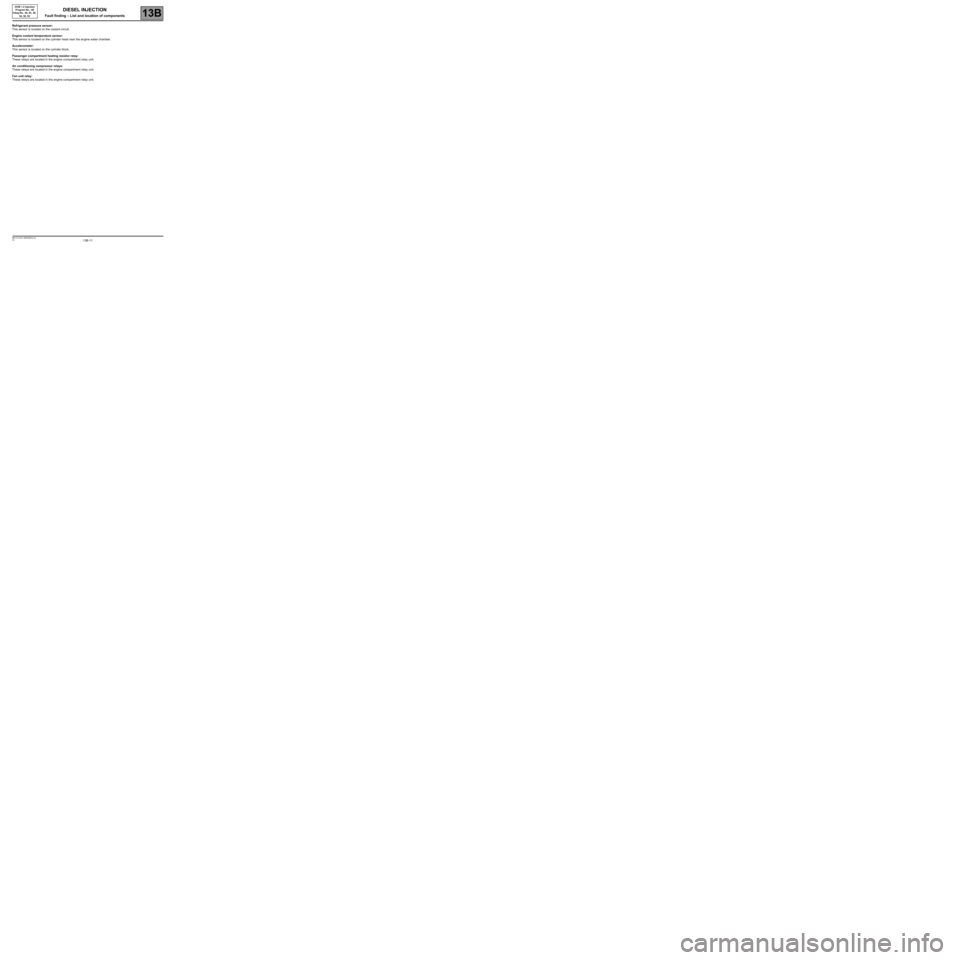
13B-11V6 MR-413-X44-13B000$030.mif
DIESEL INJECTION
Fault finding – List and location of components13B
DCM 1.2 Injection
Program No.: 4D
Vdiag No.: 48, 4C, 50,
54, 58, 5C
Refrigerant pressure sensor:
This sensor is located on the coolant circuit.
Engine coolant temperature sensor:
This sensor is located on the cylinder head near the engine water chamber.
Accelerometer:
This sensor is located on the cylinder block.
Passenger compartment heating resistor relay:
These relays are located in the engine compartment relay unit.
Air conditioning compressor relays:
These relays are located in the engine compartment relay unit.
Fan unit relay:
These relays are located in the engine compartment relay unit.
Page 12 of 269
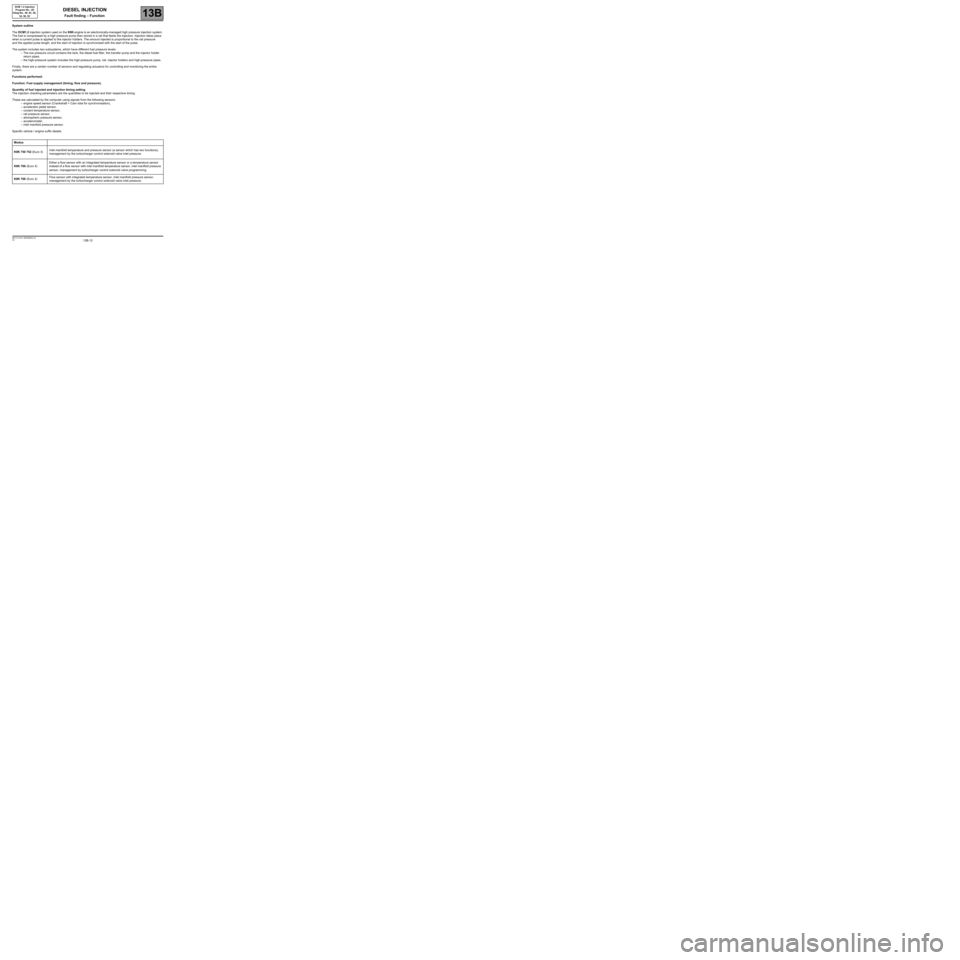
13B-12V6 MR-413-X44-13B000$040.mif
13B
DCM 1.2 Injection
Program No.: 4D
Vdiag No.: 48, 4C, 50,
54, 58, 5C
System outline
The DCM1.2 injection system used on the K9K engine is an electronically-managed high pressure injection system.
The fuel is compressed by a high pressure pump then stored in a rail that feeds the injectors. Injection takes place
when a current pulse is applied to the injector holders. The amount injected is proportional to the rail pressure
and the applied pulse length, and the start of injection is synchronised with the start of the pulse.
The system includes two subsystems, which have different fuel pressure levels:
–The low pressure circuit contains the tank, the diesel fuel filter, the transfer pump and the injector holder
return pipes,
–the high-pressure system includes the high-pressure pump, rail, injector holders and high-pressure pipes.
Finally, there are a certain number of sensors and regulating actuators for controlling and monitoring the entire
system.
Functions performed:
Function: Fuel supply management (timing, flow and pressure).
Quantity of fuel injected and injection timing setting
The injection checking parameters are the quantities to be injected and their respective timing.
These are calculated by the computer using signals from the following sensors:
–engine speed sensor (Crankshaft + Cam lobe for synchronisation),
–accelerator pedal sensor,
–coolant temperature sensor,
–rail pressure sensor,
–atmospheric pressure sensor,
–accelerometer,
–inlet manifold pressure sensor.
Specific vehicle / engine suffix details:
Modus
K9K 750 752 (Euro 3)Inlet manifold temperature and pressure sensor (a sensor which has two functions),
management by the turbocharger control solenoid valve inlet pressure.
K9K 766 (Euro 4)Either a flow sensor with an integrated temperature sensor or a temperature sensor
instead of a flow sensor with inlet manifold temperature sensor, inlet manifold pressure
sensor, management by turbocharger control solenoid valve programming.
K9K 768 (Euro 4)Flow sensor with integrated temperature sensor, inlet manifold pressure sensor,
management by the turbocharger control solenoid valve inlet pressure.
DIESEL INJECTION
Fault finding – Function
Page 14 of 269
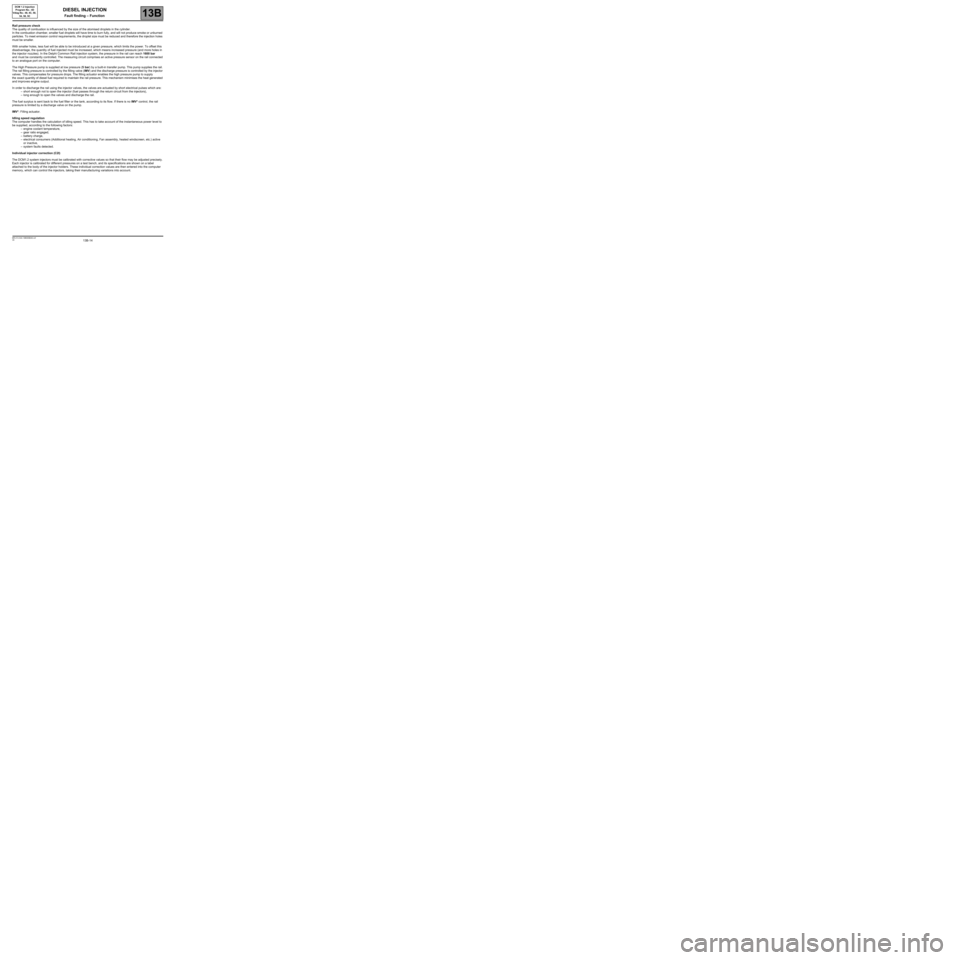
13B-14V6 MR-413-X44-13B000$040.mif
DIESEL INJECTION
Fault finding – Function13B
DCM 1.2 Injection
Program No.: 4D
Vdiag No.: 48, 4C, 50,
54, 58, 5C
Rail pressure check
The quality of combustion is influenced by the size of the atomised droplets in the cylinder.
In the combustion chamber, smaller fuel droplets will have time to burn fully, and will not produce smoke or unburned
particles. To meet emission control requirements, the droplet size must be reduced and therefore the injection holes
must be smaller.
With smaller holes, less fuel will be able to be introduced at a given pressure, which limits the power. To offset this
disadvantage, the quantity of fuel injected must be increased, which means increased pressure (and more holes in
the injector nozzles). In the Delphi Common Rail injection system, the pressure in the rail can reach 1600 bar
and must be constantly controlled. The measuring circuit comprises an active pressure sensor on the rail connected
to an analogue port on the computer.
The High Pressure pump is supplied at low pressure (5 bar) by a built-in transfer pump. This pump supplies the rail.
The rail filling pressure is controlled by the filling valve (IMV) and the discharge pressure is controlled by the injector
valves. This compensates for pressure drops. The filling actuator enables the high pressure pump to supply
the exact quantity of diesel fuel required to maintain the rail pressure. This mechanism minimises the heat generated
and improves engine output.
In order to discharge the rail using the injector valves, the valves are actuated by short electrical pulses which are:
–short enough not to open the injector (fuel passes through the return circuit from the injectors),
–long enough to open the valves and discharge the rail.
The fuel surplus is sent back to the fuel filter or the tank, according to its flow. If there is no IMV* control, the rail
pressure is limited by a discharge valve on the pump.
IMV*: Filling actuator.
Idling speed regulation
The computer handles the calculation of idling speed. This has to take account of the instantaneous power level to
be supplied, according to the following factors:
–engine coolant temperature,
–gear ratio engaged,
–battery charge,
–electrical consumers (Additional heating, Air conditioning, Fan assembly, heated windscreen, etc.) active
or inactive,
–system faults detected.
Individual injector correction (C2I)
The DCM1.2 system injectors must be calibrated with corrective values so that their flow may be adjusted precisely.
Each injector is calibrated for different pressures on a test bench, and its specifications are shown on a label
attached to the body of the injector holders. These individual correction values are then entered into the computer
memory, which can control the injectors, taking their manufacturing variations into account.
Page 17 of 269
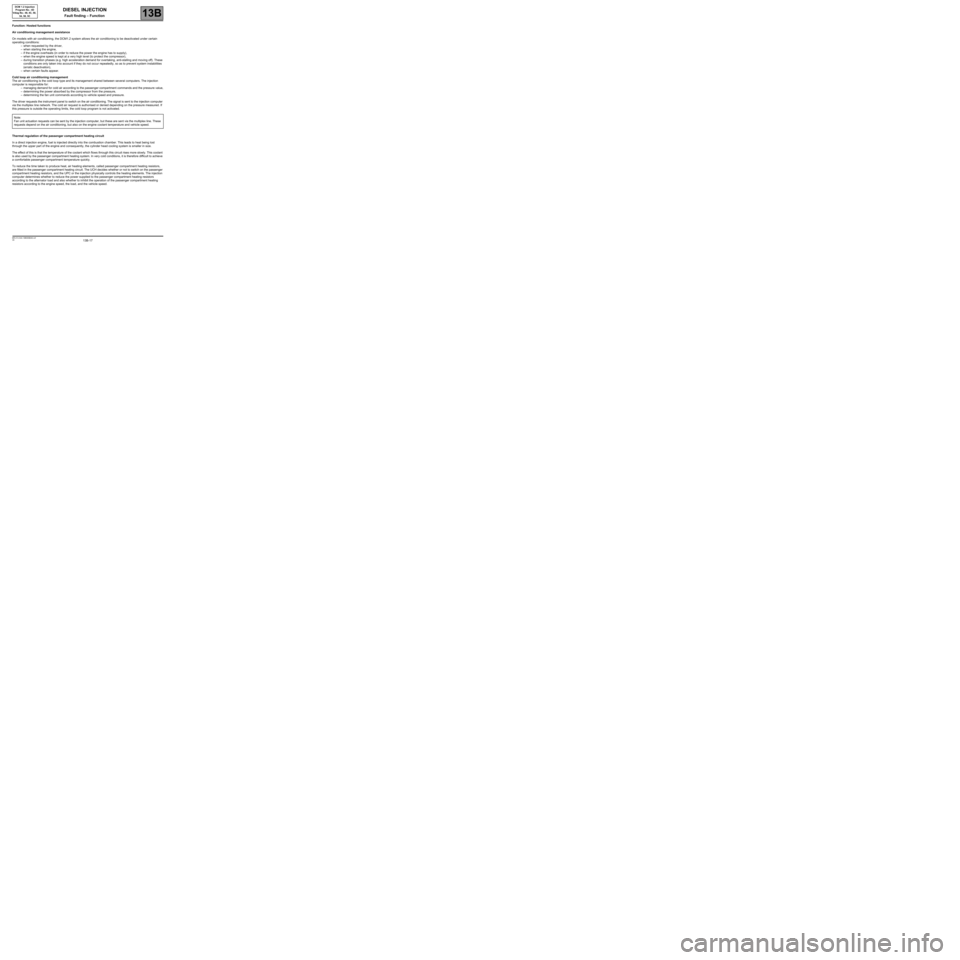
13B-17V6 MR-413-X44-13B000$040.mif
DIESEL INJECTION
Fault finding – Function13B
DCM 1.2 Injection
Program No.: 4D
Vdiag No.: 48, 4C, 50,
54, 58, 5C
Function: Hosted functions
Air conditioning management assistance
On models with air conditioning, the DCM1.2 system allows the air conditioning to be deactivated under certain
operating conditions:
–when requested by the driver,
–when starting the engine,
–if the engine overheats (in order to reduce the power the engine has to supply),
–when the engine speed is kept at a very high level (to protect the compressor),
–during transition phases (e.g. high acceleration demand for overtaking, anti-stalling and moving off). These
conditions are only taken into account if they do not occur repeatedly, so as to prevent system instabilities
(erratic deactivation),
–when certain faults appear.
Cold loop air conditioning management
The air conditioning is the cold loop type and its management shared between several computers. The injection
computer is responsible for:
–managing demand for cold air according to the passenger compartment commands and the pressure value,
–determining the power absorbed by the compressor from the pressure,
–determining the fan unit commands according to vehicle speed and pressure.
The driver requests the instrument panel to switch on the air conditioning. The signal is sent to the injection computer
via the multiplex line network. The cold air request is authorised or denied depending on the pressure measured. If
this pressure is outside the operating limits, the cold loop program is not activated.
Thermal regulation of the passenger compartment heating circuit
In a direct injection engine, fuel is injected directly into the combustion chamber. This leads to heat being lost
through the upper part of the engine and consequently, the cylinder head cooling system is smaller in size.
The effect of this is that the temperature of the coolant which flows through this circuit rises more slowly. This coolant
is also used by the passenger compartment heating system. In very cold conditions, it is therefore difficult to achieve
a comfortable passenger compartment temperature quickly.
To reduce the time taken to produce heat, air heating elements, called passenger compartment heating resistors,
are fitted in the passenger compartment heating circuit. The UCH decides whether or not to switch on the passenger
compartment heating resistors, and the UPC or the injection physically controls the heating elements. The injection
computer determines whether to reduce the power supplied to the passenger compartment heating resistors
according to the alternator load and also whether to inhibit the operation of the passenger compartment heating
resistors according to the engine speed, the load, and the vehicle speed.Note:
Fan unit actuation requests can be sent by the injection computer, but these are sent via the multiplex line. These
requests depend on the air conditioning, but also on the engine coolant temperature and vehicle speed.
Page 19 of 269
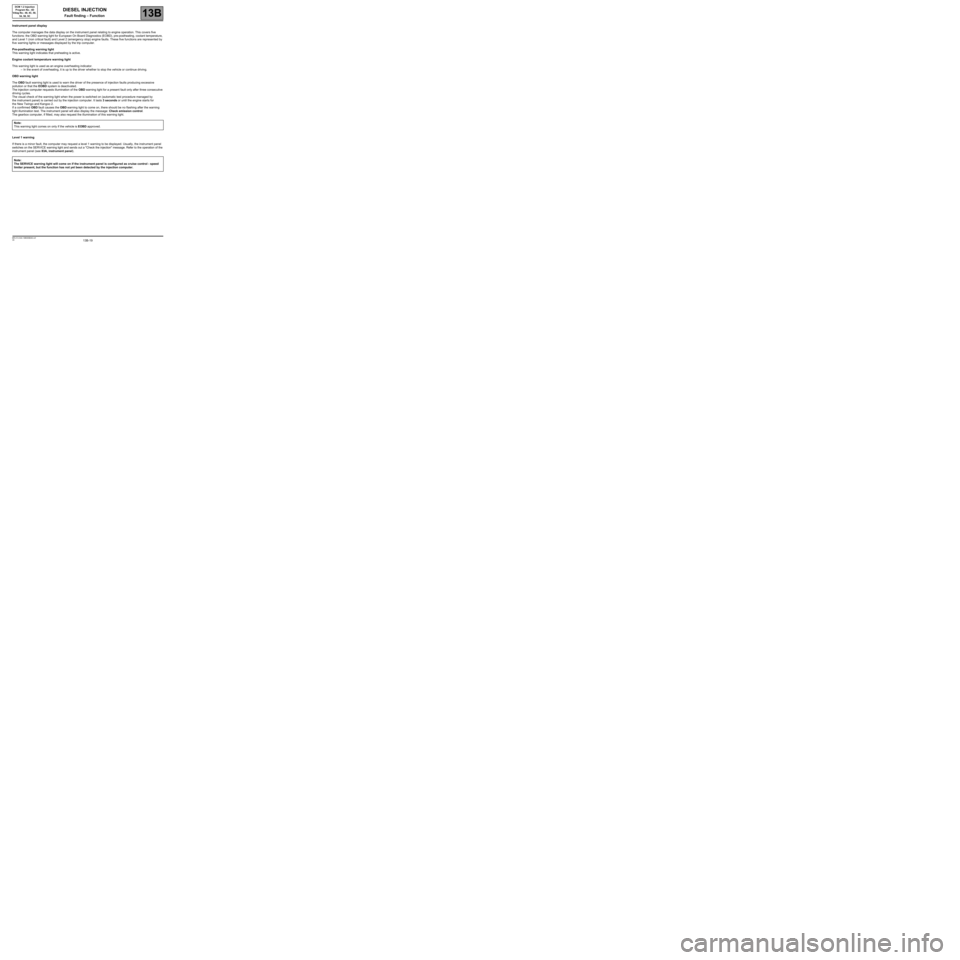
13B-19V6 MR-413-X44-13B000$040.mif
DIESEL INJECTION
Fault finding – Function13B
DCM 1.2 Injection
Program No.: 4D
Vdiag No.: 48, 4C, 50,
54, 58, 5C
Instrument panel display
The computer manages the data display on the instrument panel relating to engine operation. This covers five
functions: the OBD warning light for European On Board Diagnostics (EOBD), pre-postheating, coolant temperature,
and Level 1 (non critical fault) and Level 2 (emergency stop) engine faults. These five functions are represented by
five warning lights or messages displayed by the trip computer.
Pre-postheating warning light
This warning light indicates that preheating is active.
Engine coolant temperature warning light
This warning light is used as an engine overheating indicator.
–In the event of overheating, it is up to the driver whether to stop the vehicle or continue driving.
OBD warning light
The OBD fault warning light is used to warn the driver of the presence of injection faults producing excessive
pollution or that the EOBD system is deactivated.
The injection computer requests illumination of the OBD warning light for a present fault only after three consecutive
driving cycles.
The visual check of the warning light when the power is switched on (automatic test procedure managed by
the instrument panel) is carried out by the injection computer. It lasts 3 seconds or until the engine starts for
the New Twingo and Kangoo 2.
If a confirmed OBD fault causes the OBD warning light to come on, there should be no flashing after the warning
light illumination test. The instrument panel will also display the message: Check emission control.
The gearbox computer, if fitted, may also request the illumination of this warning light.
Level 1 warning
If there is a minor fault, the computer may request a level 1 warning to be displayed. Usually, the instrument panel
switches on the SERVICE warning light and sends out a "Check the injection" message. Refer to the operation of the
instrument panel (see 83A, instrument panel). Note:
This warning light comes on only if the vehicle is EOBD approved.
Note:
The SERVICE warning light will come on if the instrument panel is configured as cruise control - speed
limiter present, but the function has not yet been detected by the injection computer.
Page 21 of 269
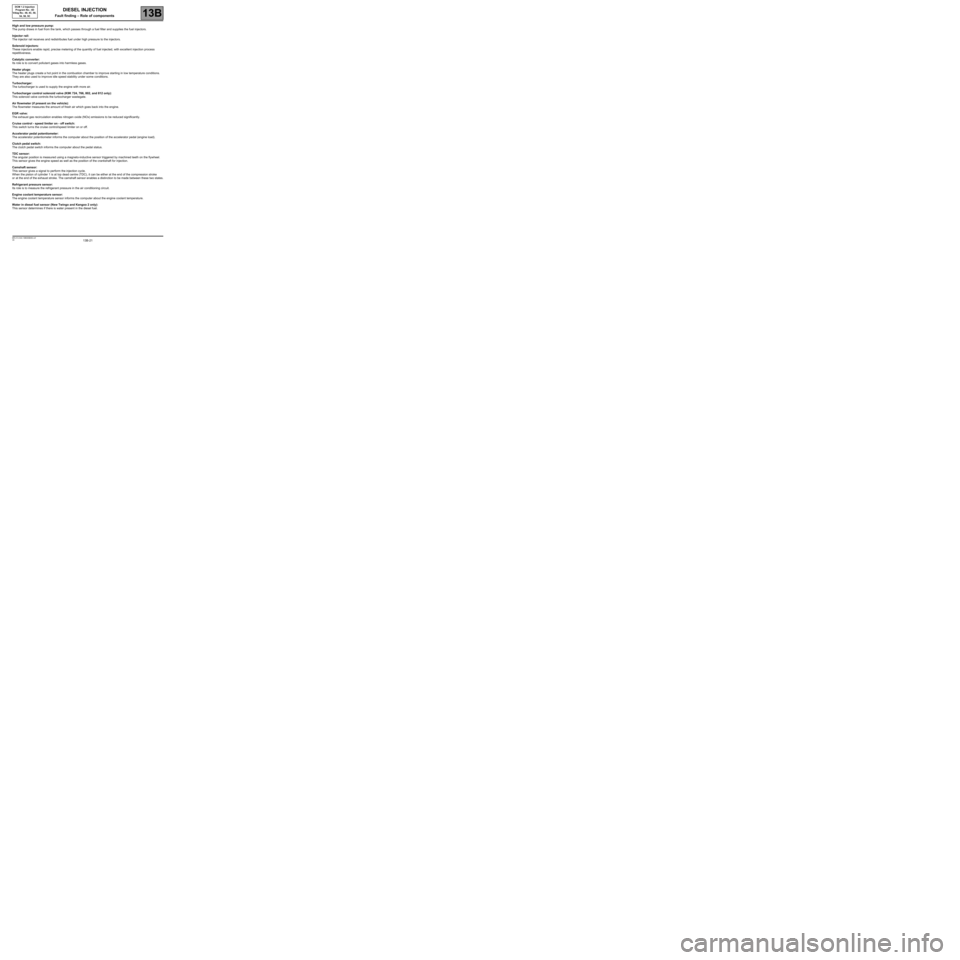
13B-21V6 MR-413-X44-13B000$050.mif
13B
DCM 1.2 Injection
Program No.: 4D
Vdiag No.: 48, 4C, 50,
54, 58, 5C
High and low pressure pump:
The pump draws in fuel from the tank, which passes through a fuel filter and supplies the fuel injectors.
Injector rail:
The injector rail receives and redistributes fuel under high pressure to the injectors.
Solenoid injectors:
These injectors enable rapid, precise metering of the quantity of fuel injected, with excellent injection process
repetitiveness.
Catalytic converter:
Its role is to convert pollutant gases into harmless gases.
Heater plugs:
The heater plugs create a hot point in the combustion chamber to improve starting in low temperature conditions.
They are also used to improve idle speed stability under some conditions.
Turbocharger:
The turbocharger is used to supply the engine with more air.
Turbocharger control solenoid valve (K9K 724, 766, 802, and 812 only):
This solenoid valve controls the turbocharger wastegate.
Air flowmeter (if present on the vehicle):
The flowmeter measures the amount of fresh air which goes back into the engine.
EGR valve:
The exhaust gas recirculation enables nitrogen oxide (NOx) emissions to be reduced significantly.
Cruise control - speed limiter on - off switch:
This switch turns the cruise control/speed limiter on or off.
Accelerator pedal potentiometer:
The accelerator potentiometer informs the computer about the position of the accelerator pedal (engine load).
Clutch pedal switch:
The clutch pedal switch informs the computer about the pedal status.
TDC sensor:
The angular position is measured using a magneto-inductive sensor triggered by machined teeth on the flywheel.
This sensor gives the engine speed as well as the position of the crankshaft for injection.
Camshaft sensor:
This sensor gives a signal to perform the injection cycle.
When the piston of cylinder 1 is at top dead centre (TDC), it can be either at the end of the compression stroke
or at the end of the exhaust stroke. The camshaft sensor enables a distinction to be made between these two states.
Refrigerant pressure sensor:
Its role is to measure the refrigerant pressure in the air conditioning circuit.
Engine coolant temperature sensor:
The engine coolant temperature sensor informs the computer about the engine coolant temperature.
Water in diesel fuel sensor (New Twingo and Kangoo 2 only):
This sensor determines if there is water present in the diesel fuel.
DIESEL INJECTION
Fault finding – Role of components
Page 23 of 269
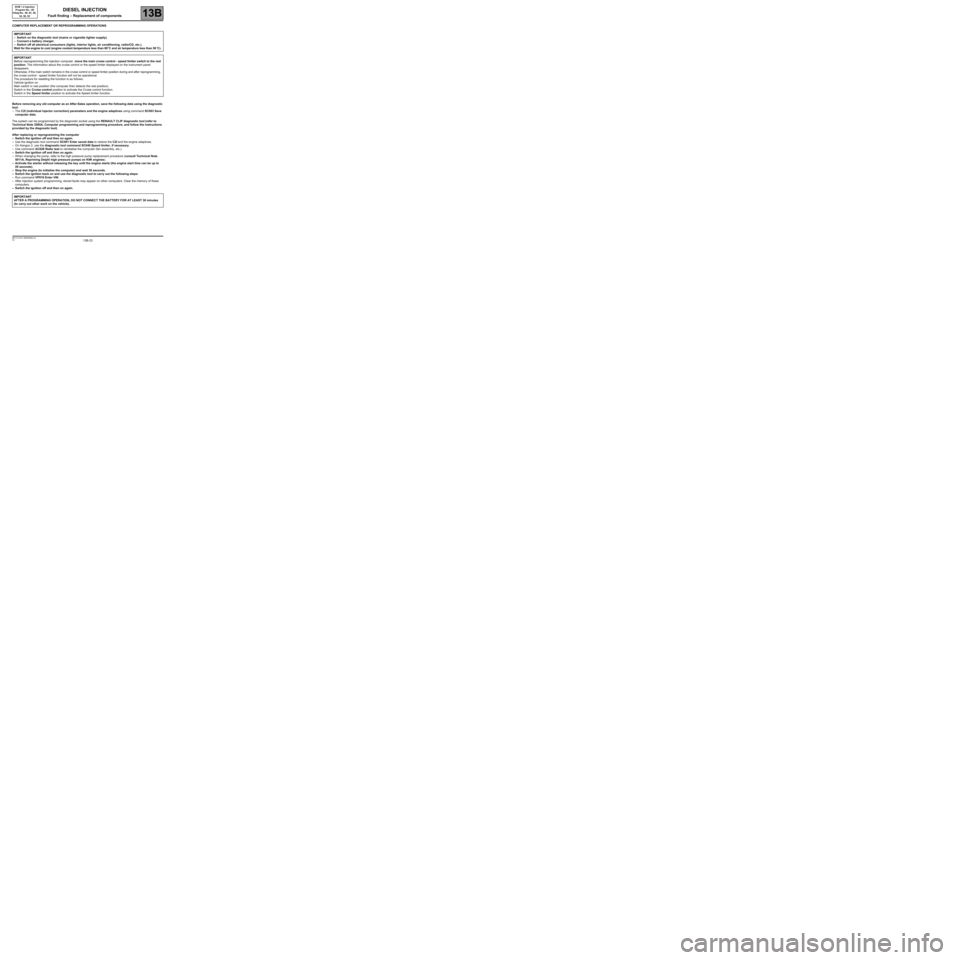
13B-23V6 MR-413-X44-13B000$060.mif
13B
DCM 1.2 Injection
Program No.: 4D
Vdiag No.: 48, 4C, 50,
54, 58, 5C
COMPUTER REPLACEMENT OR REPROGRAMMING OPERATIONS
Before removing any old computer as an After-Sales operation, save the following data using the diagnostic
tool:
–The C2I (individual injector correction) parameters and the engine adaptives using command SC003 Save
computer data.
The system can be programmed by the diagnostic socket using the RENAULT CLIP diagnostic tool (refer to
Technical Note 3585A, Computer programming and reprogramming procedure, and follow the instructions
provided by the diagnostic tool).
After replacing or reprogramming the computer
–Switch the ignition off and then on again.
–Use the diagnostic tool command SC001 Enter saved data to restore the C2I and the engine adaptives.
–On Kangoo 2, use the diagnostic tool command SC040 Speed limiter, if necessary.
–Use command AC028 Static test to reinitialise the computer (fan assembly, etc.).
–Switch the ignition off and then on again.
–When changing the pump, refer to the high pressure pump replacement procedure (consult Technical Note
5011A, Repriming Delphi high pressure pumps on K9K engines).
–Activate the starter without releasing the key until the engine starts (the engine start time can be up to
20 seconds).
–Stop the engine (to initialise the computer) and wait 30 seconds.
–Switch the ignition back on and use the diagnostic tool to carry out the following steps:
–Run command VP010 Enter VIN.
–After injection system programming, stored faults may appear on other computers. Clear the memory of these
computers.
–Switch the ignition off and then on again. IMPORTANT
–Switch on the diagnostic tool (mains or cigarette lighter supply).
–Connect a battery charger.
–Switch off all electrical consumers (lights, interior lights, air conditioning, radio/CD, etc.).
Wait for the engine to cool (engine coolant temperature less than 60
°C and air temperature less than 50°C).
IMPORTANT
Before reprogramming the injection computer, move the main cruise control - speed limiter switch to the rest
position. The information about the cruise control or the speed limiter displayed on the instrument panel
disappears.
Otherwise, if the main switch remains in the cruise control or speed limiter position during and after reprogramming,
the cruise control - speed limiter function will not be operational.
The procedure for resetting the function is as follows:
Vehicle ignition on.
Main switch in rest position (the computer then detects the rest position).
Switch in the Cruise control position to activate the Cruise control function.
Switch in the Speed limiter position to activate the Speed limiter function.
IMPORTANT
AFTER A PROGRAMMING OPERATION, DO NOT CONNECT THE BATTERY FOR AT LEAST 30 minutes
(to carry out other work on the vehicle).
DIESEL INJECTION
Fault finding – Replacement of components
Page 27 of 269
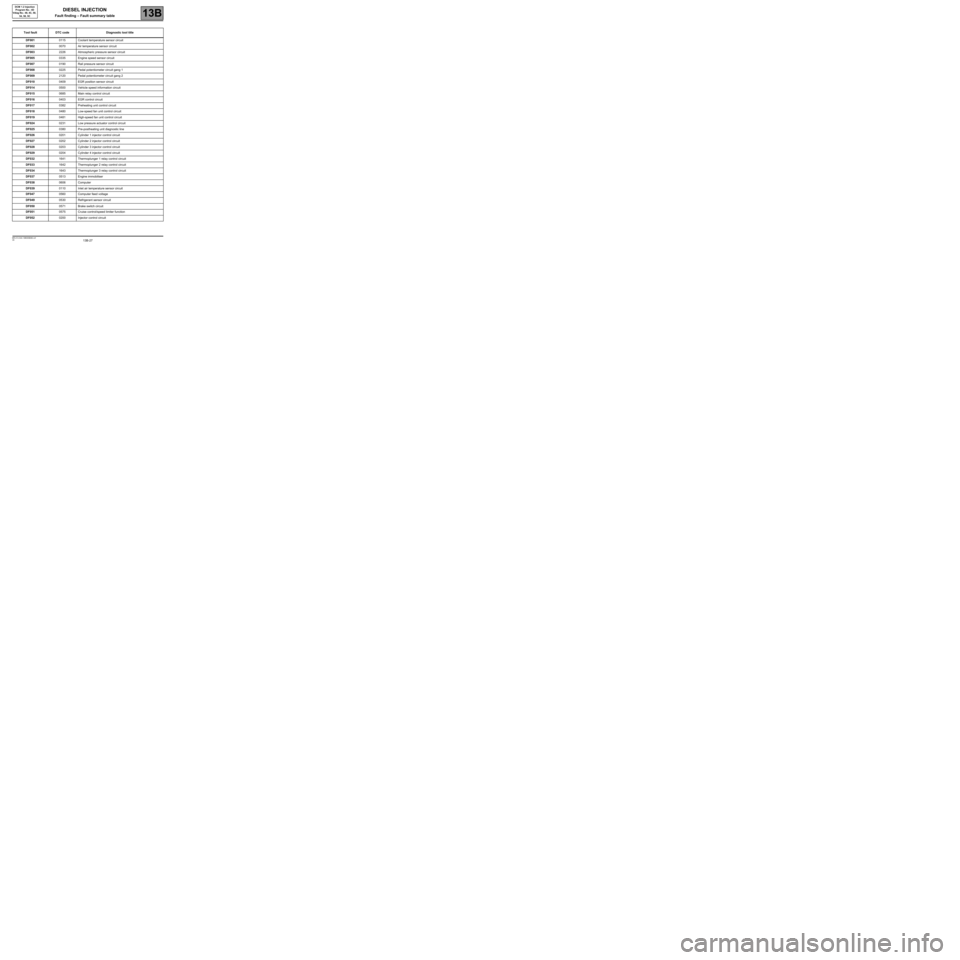
13B-27V6 MR-413-X44-13B000$080.mif
13B
DCM 1.2 Injection
Program No.: 4D
Vdiag No.: 48, 4C, 50,
54, 58, 5C
Tool faultDTC codeDiagnostic tool title
DF0010115 Coolant temperature sensor circuit
DF0020070 Air temperature sensor circuit
DF0032226 Atmospheric pressure sensor circuit
DF0050335 Engine speed sensor circuit
DF0070190 Rail pressure sensor circuit
DF0080225 Pedal potentiometer circuit gang 1
DF0092120 Pedal potentiometer circuit gang 2
DF0100409 EGR position sensor circuit
DF0140500 Vehicle speed information circuit
DF0150685 Main relay control circuit
DF0160403 EGR control circuit
DF0170382 Preheating unit control circuit
DF0180480 Low-speed fan unit control circuit
DF0190481 High-speed fan unit control circuit
DF0240231 Low pressure actuator control circuit
DF0250380 Pre-postheating unit diagnostic line
DF0260201 Cylinder 1 injector control circuit
DF0270202 Cylinder 2 injector control circuit
DF0280203 Cylinder 3 injector control circuit
DF0290204 Cylinder 4 injector control circuit
DF0321641 Thermoplunger 1 relay control circuit
DF0331642 Thermoplunger 2 relay control circuit
DF0341643 Thermoplunger 3 relay control circuit
DF0370513 Engine immobiliser
DF0380606 Computer
DF0390110 Inlet air temperature sensor circuit
DF0470560 Computer feed voltage
DF0490530 Refrigerant sensor circuit
DF0500571 Brake switch circuit
DF0510575 Cruise control/speed limiter function
DF0520200 Injector control circuit
DIESEL INJECTION
Fault finding – Fault summary table
Page 29 of 269
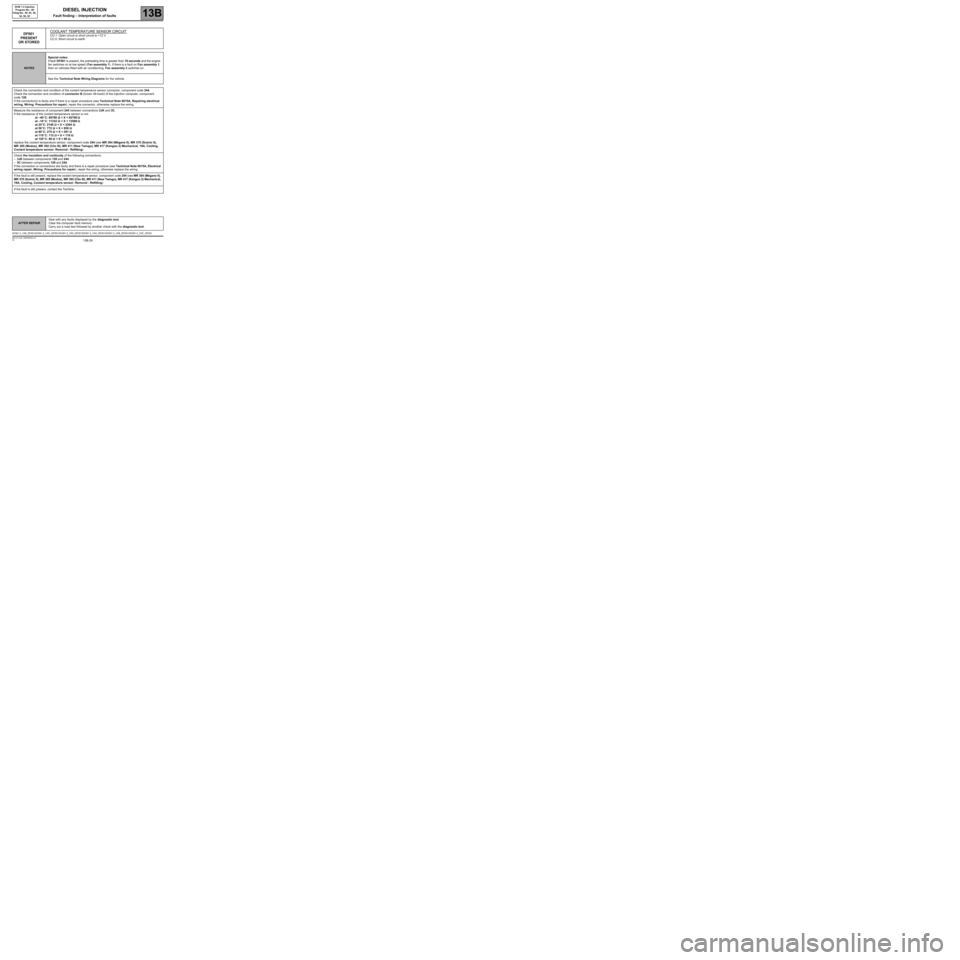
13B-29
AFTER REPAIRDeal with any faults displayed by the diagnostic tool.
Clear the computer fault memory.
Carry out a road test followed by another check with the diagnostic tool.
V6 MR-413-X44-13B000$090.mif
13B
DCM 1.2 Injection
Program No.: 4D
Vdiag No.: 48, 4C, 50,
54, 58, 5C
DF001
PRESENT
OR STOREDCOOLANT TEMPERATURE SENSOR CIRCUITCO.1: Open circuit or short circuit to +12 V
CC.0: Short circuit to earth
NOTESSpecial notes:
If fault DF001 is present, the preheating time is greater than 10 seconds and the engine
fan switches on at low speed (Fan assembly 1). If there is a fault on Fan assembly 1,
then on vehicles fitted with air conditioning, Fan assembly 2 switches on.
See the Technical Note Wiring Diagrams for the vehicle.
Check the connection and condition of the coolant temperature sensor connector, component code 244.
Check the connection and condition of connector B (brown 48-track) of the injection computer, component
code 120.
If the connector(s) is faulty and if there is a repair procedure (see Technical Note 6015A, Repairing electrical
wiring, Wiring: Precautions for repair), repair the connector, otherwise replace the wiring.
Measure the resistance of component 244 between connections 3JK and 3C.
If the resistance of the coolant temperature sensor is not:
at –40
°C: 68780 ΩΩ Ω Ω
< X < 82780 ΩΩ Ω Ω
at –10
°C: 11332 ΩΩ Ω Ω
< X < 13588 ΩΩ Ω Ω
at 25
°C: 2140 ΩΩ Ω Ω
< X < 2364 ΩΩ Ω Ω
at 50
°C: 772 ΩΩ Ω Ω
< X < 850 ΩΩ Ω Ω
at 80
°C: 275 ΩΩ Ω Ω
< X < 291 ΩΩ Ω Ω
at 110
°C: 112 ΩΩ Ω Ω
< X < 118 ΩΩ Ω Ω
at 120
°C: 86 ΩΩ Ω Ω
< X < 90 ΩΩ Ω Ω
,
replace the coolant temperature sensor, component code 244 (see MR 364 (Mégane II), MR 370 (Scénic II),
MR 385 (Modus), MR 392 (Clio III), MR 411 (New Twingo), MR 417 (Kangoo 2) Mechanical, 19A, Cooling,
Coolant temperature sensor: Removal - Refitting).
Check the insulation and continuity of the following connections:
–3JK between components 120 and 244,
–3C between components 120 and 244.
If the connection or connections are faulty and there is a repair procedure (see Technical Note 6015A, Electrical
wiring repair, Wiring: Precautions for repair), repair the wiring, otherwise replace the wiring.
If the fault is still present, replace the coolant temperature sensor, component code 244 (see MR 364 (Mégane II),
MR 370 (Scénic II), MR 385 (Modus), MR 392 (Clio III), MR 411 (New Twingo), MR 417 (Kangoo 2) Mechanical,
19A, Cooling, Coolant temperature sensor: Removal - Refitting).
If the fault is still present, contact the Techline.
DCM1.2_V48_DF001/DCM1.2_V4C_DF001/DCM1.2_V50_DF001/DCM1.2_V54_DF001/DCM1.2_V58_DF001/DCM1.2_V5C_DF001
DIESEL INJECTION
Fault finding – Interpretation of faults
Page 106 of 269
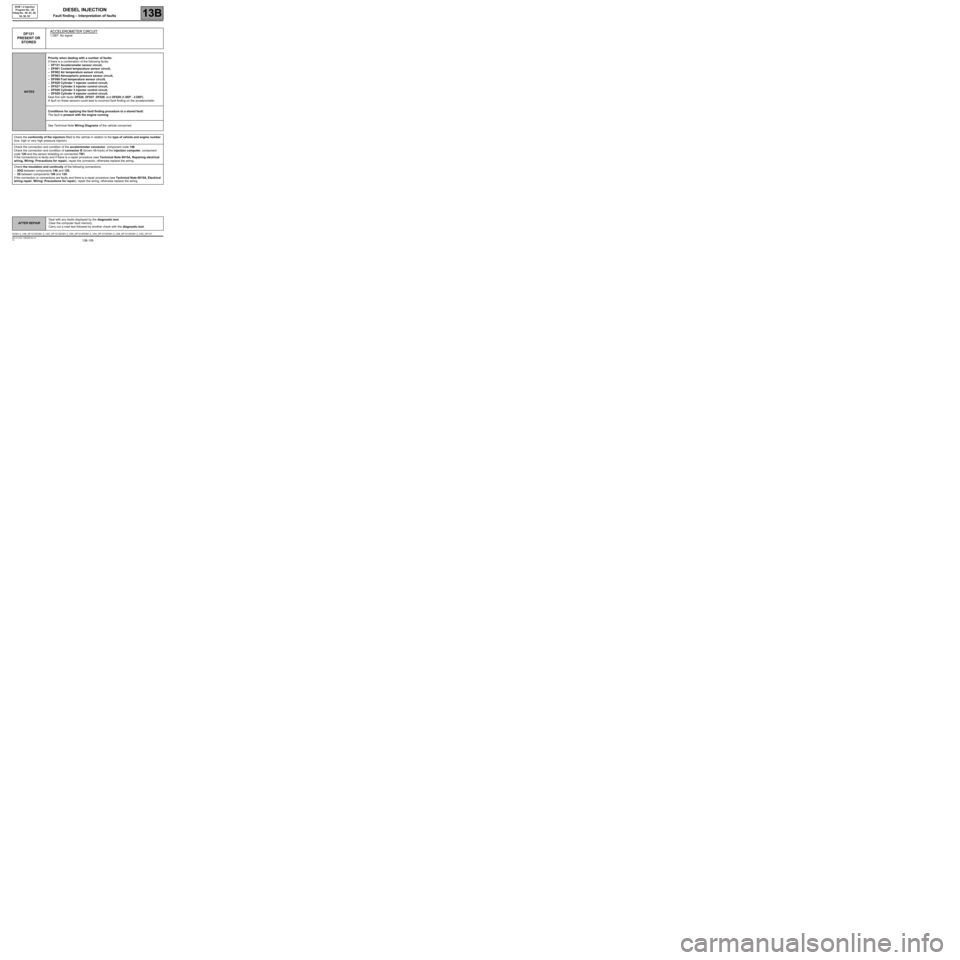
13B-106
AFTER REPAIRDeal with any faults displayed by the diagnostic tool.
Clear the computer fault memory.
Carry out a road test followed by another check with the diagnostic tool.
V6 MR-413-X44-13B000$120.mif
13B
DCM 1.2 Injection
Program No.: 4D
Vdiag No.: 48, 4C, 50,
54, 58, 5C
DF121
PRESENT OR
STOREDACCELEROMETER CIRCUIT1.DEF: No signal
NOTESPriority when dealing with a number of faults:
If there is a combination of the following faults:
–DF121 Accelerometer sensor circuit,
–DF001 Coolant temperature sensor circuit,
–DF002 Air temperature sensor circuit,
–DF003 Atmospheric pressure sensor circuit,
–DF098 Fuel temperature sensor circuit,
–DF026 Cylinder 1 injector control circuit,
–DF027 Cylinder 2 injector control circuit,
–DF028 Cylinder 3 injector control circuit,
–DF029 Cylinder 4 injector control circuit,
Deal first with faults DF026, DF027, DF028, and DF029 (1.DEF - 2.DEF).
A fault on these sensors could lead to incorrect fault finding on the accelerometer.
Conditions for applying the fault finding procedure to a stored fault:
The fault is present with the engine running.
See Technical Note Wiring Diagrams of the vehicle concerned
Check the conformity of the injectors fitted to the vehicle in relation to the type of vehicle and engine number
(low, high or very high pressure injector).
Check the connection and condition of the accelerometer connector, component code 146.
Check the connection and condition of connector B (brown 48-track) of the injection computer, component
code 120 and the sensor shielding on connection TB1.
If the connector(s) is faulty and if there is a repair procedure (see Technical Note 6015A, Repairing electrical
wiring, Wiring: Precautions for repair), repair the connector, otherwise replace the wiring.
Check the insulation and continuity of the following connections:
–3DQ between components 146 and 120,
–3S between components 146 and 120.
If the connection or connections are faulty and there is a repair procedure (see Technical Note 6015A, Electrical
wiring repair, Wiring: Precautions for repair), repair the wiring, otherwise replace the wiring.
DCM1.2_V48_DF121/DCM1.2_V4C_DF121/DCM1.2_V50_DF121/DCM1.2_V54_DF121/DCM1.2_V58_DF121/DCM1.2_V5C_DF121
DIESEL INJECTION
Fault finding – Interpretation of faults